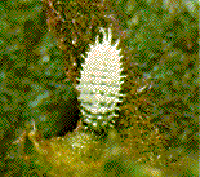|
|
Back to Pest Identification and Diagnosis
 |
Adult female |
|
| Mexican Mealybug From: NC State University |
| DESCRIPTION | |
|
Adults: The female Mexican mealybug adult is 3 to 4 millimeters long, oval, grayish and covered with a thin waxy secretion. There are
three parallel rows of small waxy tufts down the back. This insect is a short-tailed mealybug (the caudal filaments do not exceed 1/4 the body length). The lateral filaments are also short. Males are small gnat-like insects with only two wings. Adult Mexican mealybug males have four waxy, posterior filaments.
Eggs: The egg sac is white, dense, narrow, and longer than the female secreting it. Nymphs: The nymphs are small and yellowish with white waxy secretions. |
|
| BIOLOGY | |
|
Host Plants: The Mexican mealybug is found commonly on numerous ornamental plants, a few of which are aralia, chrysanthemum, English ivy, geranium, Gynura, hollyhock, Ixia, lantana, and poinsettia. This insect is also a minor pest of lima beans in the warmer parts of the United States.
Damage: Wilting and stunting are common symptoms of Mexican mealybug attack. This insect can be as damaging as the citrus mealybug. The mealybugs and ovisacs also disfigure heavily infested plants. Life Cycle: In the greenhouse, the Mexican mealybug may have seven complete generations in one year. The average time required from oviposition to the adult stage is 47 days. Each female deposits about 400 eggs. The eggs are enclosed in an elongate cottony mass called the ovisac that originates at the back of the female. The ovisac is about 6 millimeters long. The eggs hatch in 6 to 14 days. The life cycles of the male and female Mexican mealybugs differ. A female passes through three nymphal stages only. Male Mexican mealybugs pass through two nymphal stages and two resting stages (prepupal and pupal stages). Normally, these mealybugs are found above ground on the leaves, stems or flowers, but occasionally will be found feeding on the roots. |
|
| MANAGEMENT STRATEGIES | |
|
Pesticides: For chemical control recommendations, consult the Cooperative Extension Service. |
Back to Pest Identification and Diagnosis
 |
(C) Regents of the University of
Minnesota. All rights reserved. |
 |
 |